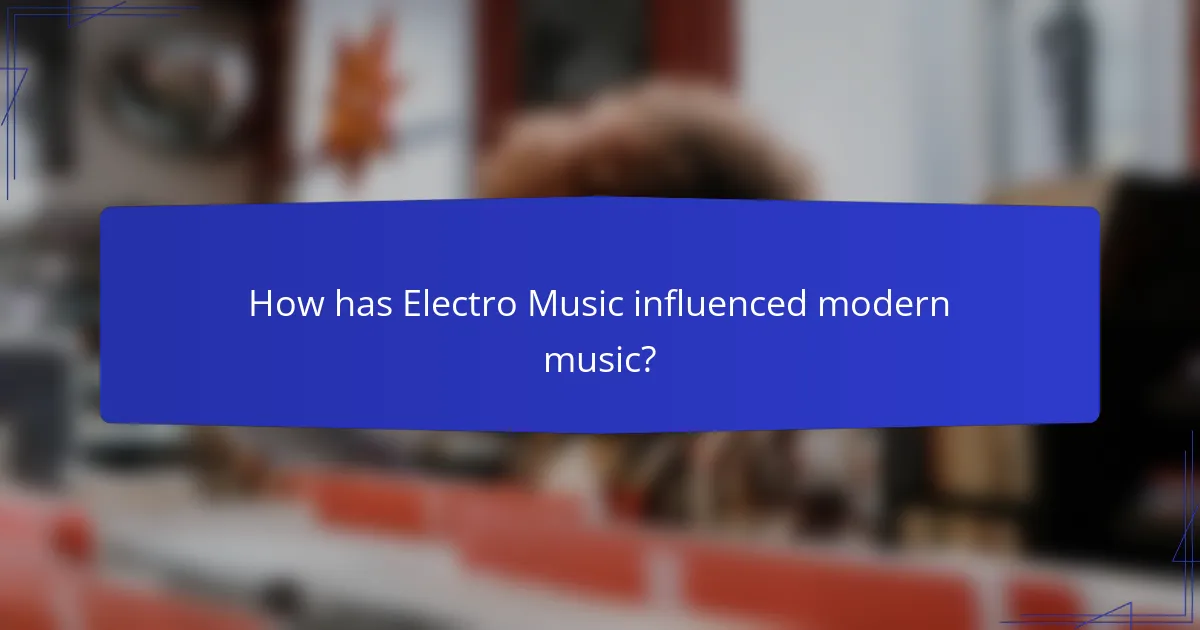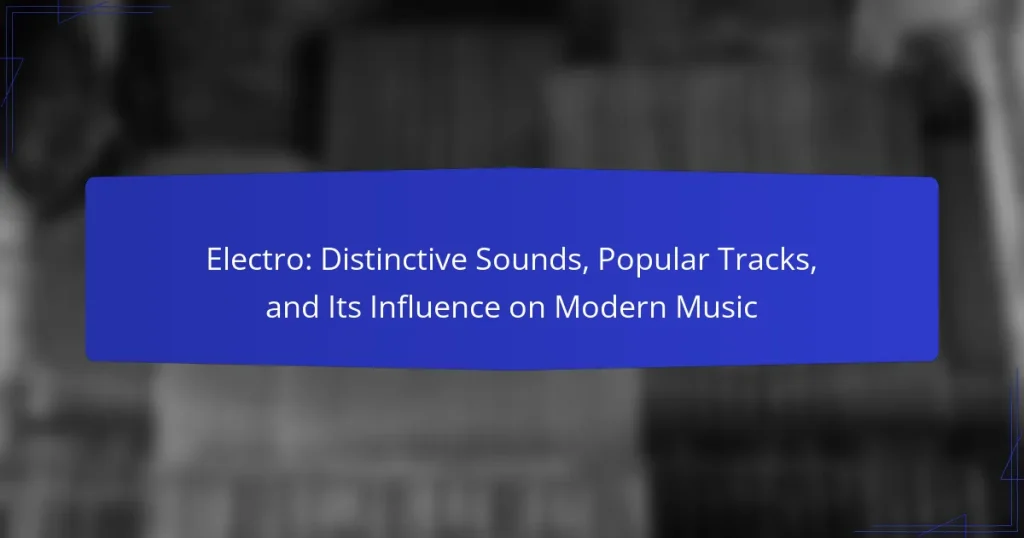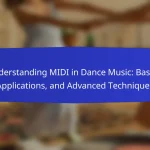Electro music is a genre that emerged in the early 1980s, combining electronic music with hip hop and funk elements. Key characteristics include the use of synthesizers, drum machines, and sequencers, alongside robotic vocals and futuristic sounds. Pioneering tracks such as “Planet Rock” by Afrika Bambaataa and “Clear” by Cybotron exemplify the genre’s innovative approach and have significantly influenced modern music, shaping genres like techno and hip hop. The article will explore notable electro tracks, their impact on contemporary music production, and the lasting legacy of electro’s distinct sound in today’s musical landscape.

What is Electro Music?
Electro music is a genre that originated in the early 1980s. It combines electronic music with elements of hip hop and funk. Characterized by its use of synthesizers, drum machines, and sequencers, electro music features robotic vocals and futuristic sounds. One of the pioneering tracks is “Planet Rock” by Afrika Bambaataa, released in 1982. This track exemplified the genre’s innovative approach to rhythm and melody. Electro music has influenced various genres, including techno and hip hop. Its distinct sound continues to resonate in modern music today.
How did Electro Music originate?
Electro music originated in the late 1970s and early 1980s. It emerged from the fusion of electronic music and hip-hop culture. Pioneering artists like Kraftwerk and Afrika Bambaataa played crucial roles in its development. Kraftwerk’s use of synthesizers influenced the sound of electro. Afrika Bambaataa’s track “Planet Rock” is often cited as a seminal electro piece. The genre is characterized by its use of drum machines and synthesizers. Electro music gained popularity in urban areas, particularly in New York City. Its innovative sound has influenced various music genres, including hip-hop and dance music.
What are the key historical milestones in the development of Electro Music?
Electro music has several key historical milestones. The genre emerged in the early 1980s. Pioneers like Afrika Bambaataa popularized electro with tracks like “Planet Rock.” This song combined hip-hop with electronic sounds. The use of drum machines, such as the Roland TR-808, became iconic in electro. In 1982, the release of “Numbers” by Kraftwerk further influenced the genre. The late 1980s saw electro evolve into various subgenres, including Miami bass and electroclash. In the 2000s, artists like Justice and Daft Punk revitalized interest in electro music. These milestones shaped the development and popularity of electro in modern music.
Who were the pioneers of Electro Music?
The pioneers of Electro Music include Afrika Bambaataa, Kraftwerk, and Juan Atkins. Afrika Bambaataa is known for his influential track “Planet Rock,” released in 1982. Kraftwerk, a German band, contributed significantly with their innovative use of synthesizers. Their album “Computer World,” released in 1986, showcased the genre’s potential. Juan Atkins, often referred to as the “Godfather of Techno,” released “No UFOs” in 1985, blending electro and techno sounds. These artists laid the groundwork for the Electro genre, shaping its development and influence on modern music.
What are the distinctive sounds of Electro Music?
Electro music is characterized by distinctive sounds such as synthesized melodies, robotic vocals, and drum machine beats. These elements create a futuristic and often mechanical soundscape. Synthesizers produce a wide range of tones, from sharp and staccato to smooth and flowing. Drum machines provide a consistent and rhythmic foundation, often featuring syncopated patterns. The use of vocoders adds a unique robotic quality to vocals, enhancing the genre’s electronic feel. Additionally, effects like reverb and delay are commonly applied, enriching the overall sound. Historical tracks, such as “Planet Rock” by Afrika Bambaataa, exemplify these distinctive sounds, solidifying electro’s influence in modern music.
How do synthesizers shape the sound of Electro Music?
Synthesizers shape the sound of Electro Music by generating a wide range of electronic tones and textures. They allow for the creation of unique sounds that traditional instruments cannot produce. Synthesizers utilize oscillators, filters, and modulation to manipulate sound waves. This results in distinctive bass lines, leads, and atmospheric pads commonly found in Electro tracks. The use of MIDI technology enables precise control over these sounds, facilitating complex arrangements. Additionally, synthesizers can emulate various musical styles, adding versatility to Electro Music. Their ability to layer sounds creates rich, immersive audio experiences. Historically, synthesizers like the Roland TR-808 and Moog Voyager have significantly influenced the genre’s development.
What role do drum machines play in Electro Music production?
Drum machines are essential tools in Electro Music production. They provide rhythmic patterns that define the genre’s sound. These devices allow for precise control over tempo and beat structure. Drum machines can create unique sounds that are not typically found in traditional percussion instruments. They enable producers to layer multiple beats and samples seamlessly. The use of drum machines started in the late 1970s and became prominent in the 1980s. Iconic tracks like “Planet Rock” by Afrika Bambaataa showcased their capabilities. Today, drum machines continue to influence modern music across various genres.
What are the subgenres of Electro Music?
Electro music has several prominent subgenres. These include Electroclash, which blends punk and electronic music. Another subgenre is Electro House, characterized by its heavy bass and high energy. Then there is Glitch Electro, known for its use of digital errors and unconventional sounds. Additionally, there is Synthpop, which incorporates synthesizers and catchy melodies. Each subgenre has unique characteristics that differentiate it from the others. For instance, Electroclash often features retro aesthetics and ironic lyrics. Electro House is widely played in dance clubs and festivals. Glitch Electro emphasizes experimentation with sound design. Synthpop has roots in the 1980s and remains influential today. These subgenres contribute to the diverse landscape of Electro music.
How does Electro differ from other electronic music genres?
Electro differs from other electronic music genres primarily through its use of syncopated rhythms and distinct bass lines. It often incorporates elements from funk and hip-hop, setting it apart from genres like techno or house. Electro typically features robotic vocals and synthesizer melodies, creating a unique sound. The genre emerged in the early 1980s, influenced by artists like Afrika Bambaataa and Kraftwerk. Its characteristic sound is defined by the use of drum machines, particularly the Roland TR-808. Electro also emphasizes a futuristic aesthetic, both in music and visual presentation. This genre has influenced various modern styles, including electro-pop and bass music.
What are some notable subgenres within Electro Music?
Notable subgenres within Electro Music include Electroclash, Electro House, and Synthpop. Electroclash emerged in the late 1990s, blending punk and electronic music. It features a retro aesthetic and influences from new wave and techno. Electro House, popular in the 2000s, is characterized by heavy basslines and upbeat tempos. It often incorporates elements of house music and progressive house. Synthpop, which gained traction in the 1980s, focuses on synthesizers and catchy melodies. It heavily influenced pop music and is known for its melodic hooks and electronic instrumentation. Each subgenre showcases distinct characteristics that contribute to the broader Electro Music landscape.

What are the most popular Electro tracks?
The most popular Electro tracks include “Planet Rock” by Afrika Bambaataa, “Clear” by Cybotron, and “Numbers” by Kraftwerk. “Planet Rock” is often credited with pioneering the Electro genre, released in 1982. “Clear,” released in 1983, is another foundational track known for its innovative use of synthesizers. “Numbers” from 1986 showcases Kraftwerk’s influence on electronic music. Other notable tracks are “Electric Kingdom” by Twilight 22 and “Let’s Go” by The Newcleus. These tracks have significantly shaped the Electro sound and its evolution in modern music.
Which Electro tracks have achieved commercial success?
“Electro tracks that have achieved commercial success include ‘Sandstorm’ by Darude and ‘One More Time’ by Daft Punk. ‘Sandstorm’ reached high positions on charts globally and became an iconic anthem in electronic music. ‘One More Time’ topped the charts in several countries and solidified Daft Punk’s status in the music industry. Other notable tracks are ‘Satisfaction’ by Benny Benassi and ‘Titanium’ by David Guetta featuring Sia. ‘Satisfaction’ was a massive hit in the early 2000s, while ‘Titanium’ has garnered billions of streams, showcasing its lasting popularity.”
What are the defining features of these popular Electro tracks?
Popular Electro tracks are characterized by their use of synthesized sounds, rhythmic beats, and electronic instrumentation. These tracks often feature repetitive melodies and hooks that create an engaging listening experience. The tempo of Electro music typically ranges from 120 to 140 BPM, providing a danceable rhythm. Vocals in Electro tracks are often processed with effects, adding to the electronic feel. Additionally, many tracks incorporate elements of funk and disco, contributing to their energetic vibe. The genre frequently utilizes drum machines and sequencers to create intricate patterns. Overall, the defining features of popular Electro tracks are their distinct sound design and infectious grooves.
How have these tracks influenced the charts and music trends?
Electro tracks have significantly influenced music charts and trends by introducing innovative sounds and production techniques. This genre has led to the rise of electronic dance music (EDM) in mainstream culture. Tracks like “Around the World” by Daft Punk and “Sandstorm” by Darude have topped charts globally. Their success paved the way for artists to integrate electronic elements into various genres. The popularity of electro has also influenced festival culture, with events like Tomorrowland and Ultra Music Festival gaining massive attendance. Additionally, collaborations between electro artists and pop musicians have created crossover hits, further solidifying the genre’s impact. The evolution of streaming platforms has allowed electro tracks to gain traction and reach wider audiences, shaping current music trends.
Who are the most influential Electro artists?
The most influential Electro artists include Kraftwerk, Afrika Bambaataa, and Daft Punk. Kraftwerk is known for pioneering electronic music in the 1970s. Their album “Autobahn” showcased innovative sounds and techniques. Afrika Bambaataa popularized Electro through his track “Planet Rock” in 1982. This song fused hip-hop with electronic beats, influencing many genres. Daft Punk, active since the 1990s, brought Electro to mainstream audiences. Their hits like “Around the World” and “One More Time” defined the genre’s modern sound. Each of these artists has significantly shaped Electro music’s evolution and cultural impact.
What contributions have these artists made to the Electro genre?
Various artists have significantly shaped the Electro genre through innovative sounds and techniques. Artists like Kraftwerk pioneered the use of synthesizers and drum machines, establishing the genre’s electronic foundation. Afrika Bambaataa introduced elements of hip-hop, blending them with electronic music, which expanded Electro’s reach. Additionally, artists such as Juan Atkins and Derrick May developed the Detroit techno sound, which is rooted in Electro. Their contributions include creating iconic tracks that defined the genre’s early landscape. The impact of these artists is evident in the evolution of various electronic music styles today. Their work laid the groundwork for future generations of musicians and producers.
How have these artists shaped the perception of Electro Music?
Artists have significantly shaped the perception of Electro Music by introducing innovative sounds and styles. Pioneers like Kraftwerk established the genre’s foundation with electronic beats and synthesizers in the 1970s. Their influence is evident in modern electronic music and pop. Artists such as Daft Punk popularized Electro through mainstream hits, blending house and disco elements. This fusion expanded the audience for Electro Music. Additionally, artists like Aphex Twin pushed boundaries with experimental sounds. Their work challenged traditional music norms and attracted diverse listeners. The emergence of festivals dedicated to Electro further solidified its cultural relevance. Overall, these artists have transformed Electro Music into a dynamic and influential genre.
What role do remixes play in the popularity of Electro tracks?
Remixes significantly enhance the popularity of Electro tracks. They introduce existing songs to new audiences. This process often revitalizes interest in original tracks. Remixes can also showcase different styles and interpretations. They allow artists to collaborate and reach diverse fan bases. The sharing culture on platforms like SoundCloud amplifies remix exposure. Additionally, remixes often feature in DJ sets, increasing their reach. According to a study by the International Journal of Music Business Research, remixes can lead to higher chart placements. This demonstrates their impact on the commercial success of Electro music.
How do remixes enhance or transform original Electro tracks?
Remixes enhance or transform original Electro tracks by introducing new elements and perspectives. They often incorporate different beats, melodies, or vocal samples. This process can create a fresh listening experience for audiences. Remixes can also appeal to diverse musical tastes. For example, a remix might shift the genre from Electro to a more mainstream sound. This can increase the track’s reach and popularity. Additionally, remixes allow artists to showcase their creativity. They can reinterpret the original work in unique ways. This can lead to innovative soundscapes and arrangements. Overall, remixes play a vital role in the evolution of Electro music.
What are some famous Electro remixes that gained recognition?
Some famous Electro remixes that gained recognition include “Electric Feel” by Justice and “Titanium” by David Guetta featuring Sia. Justice’s remix of “Electric Feel” became a defining track in the Electro genre. It showcased a unique blend of electronic beats and catchy melodies. David Guetta’s “Titanium” remix further popularized Electro with its powerful vocals and energetic production. Both tracks received extensive airplay and critical acclaim. They contributed significantly to the mainstream acceptance of Electro music.

How has Electro Music influenced modern music?
Electro music has significantly influenced modern music by introducing unique sounds and production techniques. Its use of synthesizers and drum machines has shaped genres like hip-hop, pop, and electronic dance music. Artists such as Afrika Bambaataa and Kraftwerk pioneered these sounds in the 1980s. Their innovative approaches laid the groundwork for future music production. The incorporation of electronic elements has led to the rise of subgenres like synth-pop and techno. Additionally, modern artists frequently sample electro tracks, demonstrating its lasting impact. The genre’s emphasis on rhythm and bass has also influenced contemporary music’s structure and style. Overall, electro music’s legacy is evident in the diverse soundscapes of today’s musical landscape.
What impact has Electro Music had on contemporary genres?
Electro music has significantly influenced contemporary genres by introducing unique sounds and production techniques. Its emphasis on synthesizers and drum machines has shaped the sound of pop, hip-hop, and dance music. Many contemporary artists incorporate electro elements to create innovative tracks. For example, artists like Daft Punk and The Weeknd have blended electro with pop and R&B. This fusion has led to the rise of subgenres like synth-pop and EDM. Electro’s impact is evident in the rhythmic and melodic structures of modern music. Its legacy continues to inspire new generations of musicians and producers.
How has Electro Music influenced pop music production?
Electro music has significantly influenced pop music production by introducing new sounds and production techniques. The use of synthesizers and drum machines in electro has shaped the sonic landscape of pop music. Artists like Kraftwerk pioneered electronic sounds that became foundational in pop. The incorporation of repetitive beats and catchy hooks from electro has enhanced pop’s appeal. Additionally, the genre’s emphasis on rhythm and texture has led to innovative arrangements in pop songs. Collaborations between electro and pop artists have further blurred genre lines. The rise of electronic dance music (EDM) has roots in electro, impacting mainstream pop trends. Overall, electro’s influence is evident in the evolving sound of contemporary pop music.
What elements of Electro can be found in hip-hop and R&B?
Electro elements in hip-hop and R&B include synthesizers, drum machines, and electronic beats. Synthesizers create unique soundscapes and melodies. Drum machines provide a rhythmic foundation, often imitating live drums. Electronic beats enhance the groove and energy of tracks. Artists like Afrika Bambaataa and Herbie Hancock incorporated these elements in their music. The use of vocoders and samples is also prevalent. These features contribute to the genre’s distinctive sound. The crossover between electro and hip-hop emerged in the 1980s, influencing numerous artists today.
How do collaborations between Electro artists and mainstream musicians shape music trends?
Collaborations between Electro artists and mainstream musicians significantly shape music trends by blending genres and expanding audience reach. These partnerships introduce Electro elements into popular music, creating new sounds that attract diverse listeners. For instance, the collaboration between Calvin Harris and Rihanna on “This Is What You Came For” fused Electro with pop, resulting in a chart-topping hit. Such collaborations often lead to increased streaming numbers and radio play, influencing what sounds become mainstream. Additionally, they encourage other artists to experiment with Electro styles, further embedding these sounds in contemporary music. The rise of Electro-infused tracks in various genres illustrates this trend, showcasing its impact on the music landscape.
What are some notable collaborations that highlight this influence?
Notable collaborations in electro music include Daft Punk’s work with Pharrell Williams on “Get Lucky.” This track exemplifies the fusion of electronic and pop elements. Another significant collaboration is Calvin Harris with Rihanna on “We Found Love.” This song showcases the mainstream appeal of electro-infused pop. Additionally, The Chainsmokers’ partnership with Halsey on “Closer” highlights the genre’s influence on contemporary music charts. These collaborations demonstrate how electro music has shaped popular music trends and broadened its audience.
How do these collaborations bridge the gap between genres?
Collaborations between artists from different genres create a fusion of sounds and styles. This blending exposes audiences to diverse musical influences. For example, an electronic artist working with a rock band can introduce electronic elements into rock music. This results in a unique sound that attracts fans from both genres. Additionally, collaborations often lead to innovative production techniques. They encourage artists to experiment beyond their traditional boundaries. Statistically, crossover hits often achieve higher chart rankings, indicating broad appeal. Such collaborations enhance creativity and expand the listener base, ultimately bridging genre divides.
What are the future trends of Electro Music?
The future trends of Electro Music include increased integration of artificial intelligence in music production. AI tools are being developed to assist artists in creating unique sounds and compositions. Another trend is the rise of immersive experiences through virtual reality concerts. These events allow fans to engage with artists in new ways. Additionally, collaborations between genres are expected to grow, blending Electro with pop, hip-hop, and classical music. This fusion can attract a wider audience. Sustainability in music production is also gaining attention. Artists are seeking eco-friendly practices in their work. Finally, the use of blockchain technology for music distribution is anticipated to change how artists monetize their work. These trends reflect the evolving landscape of Electro Music and its adaptability to technological advancements.
How is technology advancing the sound of Electro Music?
Technology is advancing the sound of Electro Music primarily through innovative software and hardware tools. Digital audio workstations (DAWs) enable producers to create complex soundscapes. Synthesizers have evolved, offering a wider range of sounds and capabilities. Sampling technology allows artists to incorporate diverse audio elements seamlessly. Advanced plugins enhance sound manipulation and processing. Artificial intelligence is starting to assist in music composition and sound design. These advancements lead to richer, more intricate musical experiences. The integration of technology has significantly shaped the genre’s evolution and accessibility.
What emerging artists are pushing the boundaries of Electro Music?
Emerging artists pushing the boundaries of Electro Music include Shlohmo, SOPHIE, and A.G. Cook. Shlohmo blends ambient and experimental sounds, creating unique textures. SOPHIE is known for innovative production techniques and genre-defying tracks. A.G. Cook incorporates pop elements into Electro, expanding its appeal. Each artist challenges traditional Electro norms. Their work showcases diverse influences and fresh perspectives. This evolution reflects the genre’s adaptability and growth.
What tips can help new listeners appreciate Electro Music?
To appreciate Electro Music, new listeners should explore its diverse subgenres. Electro encompasses styles like synth-pop, techno, and electro-funk. Familiarizing oneself with iconic tracks can enhance understanding. Listening to artists such as Kraftwerk and Afrika Bambaataa provides historical context. Attending live performances introduces the energetic atmosphere of Electro. Engaging with online communities allows for shared recommendations and insights. Experimenting with different listening environments, such as headphones versus speakers, can alter the experience. Understanding the production techniques, like sampling and synthesizers, enriches appreciation. Finally, keeping an open mind to the genre’s evolution fosters a deeper connection to its sounds.
How can one identify key characteristics of Electro tracks?
Electro tracks can be identified by their distinct use of synthesizers and drum machines. The genre typically features a strong, repetitive beat. Common tempos range from 120 to 130 BPM. Electro tracks often incorporate futuristic sounds and robotic vocals. They frequently utilize syncopated basslines and melodic hooks. The genre is characterized by its electronic instrumentation and sampling techniques. Key influences include funk, hip hop, and electronic dance music. These attributes contribute to the overall energetic and dynamic feel of Electro music.
What are some recommended playlists or albums for beginners in Electro Music?
Recommended playlists for beginners in Electro Music include “Electro Essentials” and “Future Electro Beats.” Notable albums are “Computer World” by Kraftwerk and “In Sides” by Orbital. These selections highlight foundational tracks and influential artists. “Electro Essentials” features key tracks that define the genre. “Computer World” is considered a classic, showcasing pioneering electronic sounds. “In Sides” blends different electronic styles, making it accessible for newcomers. These playlists and albums provide a solid introduction to Electro Music.
Electro is a music genre that originated in the early 1980s, merging electronic music with hip hop and funk. The article explores the distinctive sounds of electro, its historical milestones, and influential artists like Afrika Bambaataa and Kraftwerk, highlighting key tracks such as “Planet Rock” and “Numbers.” It also examines the genre’s impact on modern music, its subgenres, and how collaborations with mainstream artists have shaped music trends. Additionally, the article discusses the role of technology and emerging artists in the evolution of electro music, providing insights for new listeners to appreciate the genre.


